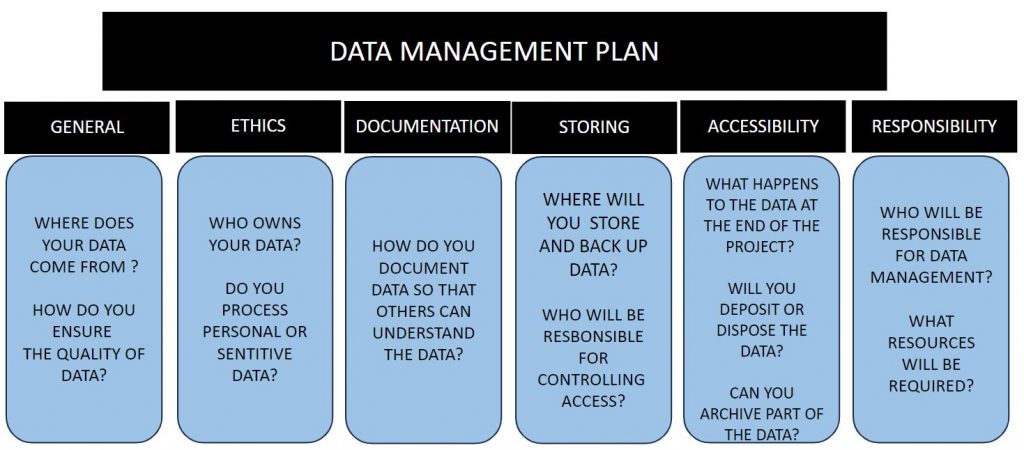Planning data management
Data management: why and how
Research Data and Data Management (RDM) is an important part of every research project. The primary goal of data and data management is to make the research process as efficient as possible. It will also help you meet the expectations and demands of your organization and research funders. In LUT Universities, preparing and maintaining a data management plan (DMP) for research, development and innovation is a requirement. In a DMP, you'll describe how you will collect, organize, analyze, preserve and share data.
RDM skills are the basic skills of a researcher, and they apply to anyone who deals with research data in a research project. By learning how to manage materials and data, you will learn to know your data. Note that your research is unique and its data management planning must be based on your own research project. You have to process your own research in your DMP, you cannot just copy ready-made sentences. Copying is not conducive to your data management.
Good research data management must be ensured from the beginning of the research process, and the data must be made usable and findable according to the FAIR principles. The data management plan should be updated during the research process. This will establish good data management practices and make your data management more efficient throughout the process. The DMP can be made using ready-made templates and tools, such as the DMPTuuli web tool.
Components of data management:
- Identifying the data
- Description of the data
- Understanding of ethical and legal issues related to the data
- Storage, sharing and opening of the data

The contents of a data management plan
A data management plan (DMP) often consists of the following sections:
1. General description of data
Where does your data came from? How do you ensure the quality of data? What data will be collected, produced or reused? In which file formats will the data be saved? Additionally, give a rough estimate of the size of the data produced/collected.
2. Ethical and legal compliance
What legal issues relate to your data management (for example, GDPR and other legislation affecting data processing)? How will you manage the rights of the data you use, produce and share? Describe how you will agree upon the rights of use related to your research data – including the collected, produced and (re)used data of your project.
Check your institutional guidelines and data security policy, and prepare to follow the instructions that are given in these guidelines.
- Research integrity in LUT intranet
- Responsible and ethical RDI in LAB LibGuides (only in Finnish)
- LUT University Research Data Policy
3. Documentation and metadata
How will you document your data to make it findable, accessible, interoperable and re-usable for you and others? What kinds of metadata standards, README files or other documentation will you use to help others understand and use your data?
4. Storage and backup during the research project
Where will your data be stored, and how will it be backed up? Describe where you will store and back up your data during your research project. Consider who will be responsible for backup and recovery. If there are several researchers involved, create a plan with your collaborators and ensure safe transfer of data between participants.
- LUT: Recommended services for storing the research data and metadata
- LAB: Best practices for storing data and metadata
5. Opening, publishing and archiving the data after the research project
What part of the data can be made openly available or published? Where and when will the data, or its metadata, be made available? Describe how you will make the data available and findable for reuse. If your data or parts of the data cannot be opened, e.g. because it contains sensitive data, explain why you will only publish or open the metadata and describe how you will open the metadata.
Where will data with long-term value be archived, and for how long? Briefly describe what part of your data you will preserve, where it will be preserved, and for how long. Long term preservation means that the data is preserved for as long as necessary, for several decades or even centuries.
6. Data management responsibilities and resources
Who (e.g. role and institution) will be responsible for data management? Consider who will be responsible for the data resulting from your project after your project has ended.
What resources will be required for your data management procedures to ensure that the data can be opened and preserved according to the FAIR principles (Findable, Accessible, Interoperable, Re-usable)?
Estimate the resources, such as time and financial costs, needed to manage, share and preserve the data. These may include storage costs, hardware, staff time, the costs of preparing data for deposit, and repository charges.
Research data life cycle

(https://www.fsd.tuni.fi/aineistonhallinta/shared/images/tutkimusaineiston_elinkaari_en.png)
Sources:
University of Eastern Finland (2024) Data management plan (DMP). Available at https://sites.uef.fi/rdm/data-management-plan-dmp/ (Accessed: 25 Sept 2024)
Finnish Social Science Data Archive (no date) Data management guidelines. Available at https://www.fsd.tuni.fi/en/services/data-management-guidelines/ (Accessed: 25 Sept 2024)
University of Helsinki (2020) What is research data management (RDM)? Available at https://blogs.helsinki.fi/thinkopen/know-your-data-rdm-series-1/ (Accessed: 25 Sept 2024)